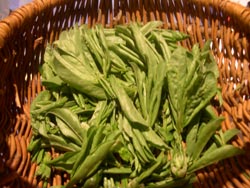Great Uncle Frank’s tip for broad beans: don’t throw away the tops of this delicate vegetable
Posted by Fiona Nevile in Vegetables, Vegetarian | 8 comments
My great grandparents took their chances in the California gold rush. It didn’t work out and they saw their four children die of scarlet fever.
They returned to England and had four more children. Three girls and a boy. Those four children would have been extra special.
Boys were best in those days as they carried on the family name. My Great Uncle Frank was the one and only boy. He contracted consumption (tuberculosis). His mother was told that he wouldn’t live beyond 21. She didn’t tell him. At twenty and 10 months he announced that he wanted to travel to South Africa.
She had to join him. The voyage would surely send him back in a coffin. He didn’t die and lived well into his eighties, which was lucky for me. He came to stay when I was 17. He was 80.
Great Uncle Frank was born in the 1890’s. Consumption meant that he lived most of his life in Switzerland. His first and second toes were the same length as his big toe. If he had been healthy he could have been a great ballet dancer. He never danced but he always shimmied to the dinner table
He talked at length about the tips of broad bean plants in spring. In England, broad beans are usually planted in February. The tips of the plants attract blackfly and are plucked at this time of year to stop the invasion. In his youth, these tips had been served as a delicacy in France.
The tips of our broad bean plants have been infested with backfly in previous years. We planted this season’s broad bean seeds back in November to help avoid blackfly and fungal diseases such as brown spot. Our plants are doing welll so I plucked the tips tonight.
46 feet of broad beans gave us a large handful. Minimal yet delicious. If a broad bean consorted with a spinach leaf, this would be their baby. Beany, spinachy and totally delicious. Wash and simmer for 2-3 mintes witout adding any more water.
If black fly haven’t invaded, why not try some?
Leave a reply





Vanessa – thank you for solving a mystery. My mother has previously told me that when she was a child, in her corner of South Africa the fruit/veg merchants were mostly Portuguese – they had their farms out in the country and the tiny shops in town. Whenever she bought soup veg from them, in amongst the standard soup ingredients was always a bunch of radishes – she never knew why as using the whole radish in the soup only made it bitter. I think you have just solved this mystery.
Hello Ted
Thanks for the tip, can’t wait to try this one!
another green to try is the tender growing tips of pumpkin plant .they seem to grow overnight
Hi Vanessa,
Thank you so much for this recipe! I looked at the radishes in the supermarket but the tops were wilty. As soon as I find some good ones I am going to try this!
When I lived in France many years ago, a friend’s mother served us a delicious soup that had a delicate, peppery flavour. She challenged her daughter (a fantastic cook and real foody) and me to guess what it was. ‘Watercress?’, no, radish tops.
I now always buy radishes with the tops and use them to make soup – it’s quick and simple, sweat some onions, add some vegetable stock and seasoning, a potato cut into small dice (to thicken the finished soup slightly), once they are tender, add the radish tops. When they have wilted, blend the soup. Sometimes I also add celery with the onions.
Hi Richard – I have waited over thirty years to taste these broad bean tips. In the gap between 17 and now, I only imagined the taste. So last night was a bit of an event.
Our BB tops were just starting to welcome black fly so a few had to be rejected. A childhood with caterpillars and slugs in the veg on my plate has made me picky. My mother always said that they were extra protein. I did not agree.
Hi Freya – glad that you liked the tale and hope that you can taste this delicacy very soon. Everyone is still talking about your Asparagus Tart.
Wonderful story about your family and great tip about the beans too! I love broad beans and this makes sure you don’t waste too much of this short season veg!
I’m keen to try this if I can – my beans are not as mature as yours yet (being planted this year rather than last) so I’m going to leave it for a while…
There’s no sign of blackfly yet (if there were I’m sure they would have drowned/blown away by now!).
Is there an organic way of getting rid of them do you know?